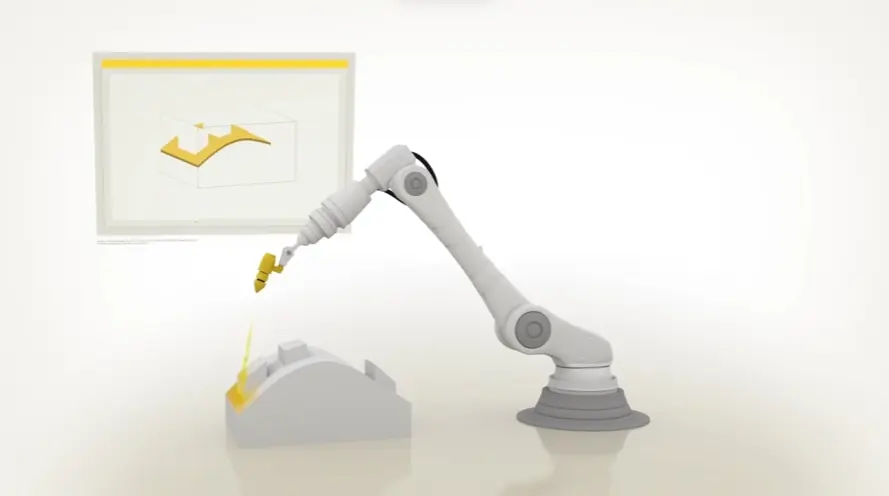*See Complexity Made Crystal Clear?* As I Explore The World Of Manufacturing, I'm Constantly Struck By The Intricate Detail Of The Products And Processes Involved, And How Challenging Explaining That Advanced Functionality Can Be.
That's Why Diving Into **3D Manufacturing Animation Examples** Is So Illuminating. These Videos Transform Dense Technical Information Into Easily Digestible, Powerful Visual Experiences, Offering Viewers An Unparalleled Look Inside, Driving Understanding And Moving Them Towards Informed Evaluations.
It’s crucial to plan ahead when it comes to high-quality video production. Discuss with our team, how you can get visual style, budget, timeline in sync.
Jai Ghosh
Video Producer at Advids
Let's talk

Can 3D animation be used to demonstrate manufacturing safety procedures?
Yes, 3D animation effectively demonstrates safety procedures by offering clear, visual step-by-step guides. It helps visualize hidden hazards and standardizes communication, reducing risk in training by avoiding real machinery and enhancing retention.
How can industrial 3D animations visualize complex manufacturing processes?
Industrial 3D animation visualizes complex processes by breaking them into clear sequences, demonstrating material flow, and showing internal machinery workings. It simplifies abstract concepts and provides a comprehensive overview of the entire production.
How does 3D animation enhance technical training in manufacturing?
3D animation enhances technical training by providing realistic, risk-free equipment simulations. It allows detailed views, breaks down procedures into steps, increases engagement, and standardizes training content globally.
How can 3D animation optimize manufacturing workflows?
3D animation optimizes workflows through simulation, helping identify bottlenecks and inefficiencies visually. It aids in planning layout changes, demonstrating material flow, and facilitating communication of process improvements to stakeholders.
How can visualizing internal mechanisms with 3D animation benefit manufacturers?
Visualizing internal mechanisms benefits manufacturers by clearly showing how parts interact and simplifying complex systems. This aids in troubleshooting, maintenance, provides deeper operator understanding, and demonstrates hidden operational principles.
What is assembly sequence visualization in manufacturing animation?
Assembly sequence visualization in manufacturing animation shows the step-by-step process of assembling a product. It clearly demonstrates the correct order and part placement, reducing errors, speeding up assembly time, and aiding new employee training.
Can 3D animation be used for demonstrating equipment operation in manufacturing?
Yes, 3D animation is effective for demonstrating equipment operation by showing startup/shutdown procedures and control functions. It allows virtual training without physical machinery access, standardizes instructions, and improves operator understanding.
How can interactive 3D visualizations be used in manufacturing?
Interactive 3D visualizations let users explore equipment from any angle, interact with components for information, and practice procedures virtually. They offer on-demand data overlays and provide a deeper, more engaging understanding through exploration.
How does 3D animation aid in visualizing product designs in manufacturing?
3D animation aids product design visualization by providing realistic representations before prototyping. It helps identify manufacturing issues early, clearly communicates design intent to production teams, and assists with design for manufacturability review.
How does engineering animation apply to the manufacturing industry?
Engineering animation applies to manufacturing by visualizing complex engineering principles and machinery function. It supports design validation, creates clear technical documentation and training, and helps communicate engineering concepts across teams.
What advantages does manufacturing animation offer?
Beyond simple visualization, a well-crafted 3D Manufacturing Animation offers businesses significant strategic advantages translating into Measurable results . They empower marketing and sales efforts by clearly communicating complex product capabilities and processes to potential customers. This clarity leads to more informed prospects, potentially shortening sales cycles and increasing qualified leads. The ability to demonstrate real-world applications builds confidence and accelerates decision-making.
Explaining intricate operations becomes clear through a detailed manufacturing process animation video, ensuring Audience comprehension and reducing ambiguity. Demonstrating Product features within relevant contexts makes solutions more relatable and believable, highlighting integration into existing workflows and solving specific industry problems. This enhanced understanding also positively impacts customer support, potentially decreasing inquiry volume as users grasp features effectively.
Optimizing the impact of these animations involves strategic analysis and adaptation. Tracking Viewer behavior through analytics reveals Audience engagement patterns, showing which segments resonate most. This data-driven approach allows for continuous improvement. Tailoring content length and style for different platforms, such as social media versus a product page, ensures maximum reach and viewer retention based on their intent and environment.
- Measuring ROI involves assessing production cost against gains like increased lead quality or Reduced support tickets .
- Analyzing viewer heatmaps and attention reveals video sections that are most engaging or potentially confusing.
- Incorporating Social proof , like brief flashes of recognized user logos, quickly builds credibility and trust.
- A/B testing different elements, from thumbnails to calls to action, helps refine content for higher conversions.
What is the core purpose of process animation?
Beyond simply illustrating mechanical steps, process animation fundamentally serves as a strategic communication asset. They empower businesses to articulate intricate mechanisms with compelling clarity, ensuring audiences grasp complex operational sequences swiftly. This visual storytelling capability propels understanding past basic explanation towards achieving specific, measurable business objectives.
The core purpose involves actively influencing viewer behavior and driving tangible outcomes. Effective animations guide prospects through Value propositions , showcasing how products integrate seamlessly into real-world workflows or solve industry-specific challenges. Presenting these authentic scenarios makes solutions inherently more relatable and believable, significantly increasing their perceived value and encouraging desired actions.
Ultimately, the animation's success ties directly to Quantifiable impact . Measuring the return on investment becomes critical, analyzing production costs against generated value streams. Key metrics include increased qualified leads, reduced length of the sales cycle due to better-informed buyers, and a decrease in support inquiries as users better understand features demonstrated visually through the animation.
- Measuring audience engagement provides deep, actionable insight. Analyzing viewer behavior through tools like heatmaps reveals precisely which segments capture attention or cause drop-off, identifying areas needing refinement for optimal viewer retention.
- Strategic placement of specific calls to action maximizes conversion potential. Instead of generic prompts, using action-oriented text directly correlated to the video's objective and viewer journey significantly impacts desired outcomes.
- Incorporating elements of social proof builds trust rapidly with potential customers. Brief inclusion of reputable client logos or relevant user statistics lends significant credibility to the presented process or product capabilities, reinforcing value.
- Optimizing content for varied viewing environments ensures maximum reach and impact; an Assembly animation video tackling a complex build sequence requires different pacing than an Engineering animation video intended for a detailed product page showcasing Internal workings .
By strategically leveraging these elements—from targeted calls to action to detailed viewer analytics—process animations transition from informative visuals to powerful engines driving engagement, understanding, and ultimately, business growth.
Ensuring technical accuracy in animation portrayal
Ensuring technical accuracy in animation portrayal goes beyond simply creating visually appealing graphics; it involves a meticulous commitment to depicting machinery and processes precisely as they operate. Creators understand that errors in movement, scale, or functionality can severely undermine credibility with a technical audience. This means diligently referencing engineering diagrams, operating manuals, and consulting with subject matter experts to guarantee every gear turn and fluid flow aligns with real-world physics and mechanics. Crafting an equipment animation video demands this level of fidelity.
Achieving this precision directly impacts how viewers perceive the presented solutions. When prospective customers see components interact correctly or a complex manufacturing step demonstrated flawlessly within a relevant context, it builds instant trust. Showing products integrated into existing workflows or illustrating how they solve specific industry problems using accurate representations makes the value proposition undeniable. This is especially crucial when developing an equipment feature animation designed to highlight specific capabilities; viewers must see the feature function exactly as it would in their own operations.
Beyond initial creation, measuring an animation's effectiveness becomes vital. They track production costs against generated value, looking for increases in qualified leads or reductions in support inquiries as indicators of success. Analyzing viewer behavior provides granular insights. Heatmaps and attention-tracking tools show exactly which parts of the animation hold attention or cause viewers to disengage.
- Action-oriented calls to action prove more effective than generic prompts, guiding viewers towards specific next steps.
- Demonstrating features within real-world scenarios enhances relatability and strengthens viewer connection.
- Incorporating social proof, like showcasing logos of satisfied users, quickly establishes credibility.
- A/B testing different animation elements allows teams to identify what resonates most and optimize for higher conversions.
Ultimately, precision in technical representation convinces the audience of the product's reliability and the animation's integrity.
Visualizing manufacturing workflows clearly
Effective workflow visualization goes beyond simply showing processes; it demands strategic execution to truly engage viewers and deliver measurable results. Teams creating these visual assets must think critically about guiding the audience toward desired actions once the animation concludes. This involves replacing vague prompts with clear, action-oriented calls. For example, suggesting "Download the Report" or "Request a Demo" aligns better with specific objectives than a generic invitation to learn more, tailoring the message to the viewer's likely stage in their journey.
Analyzing viewer interactions provides invaluable insights. Tools like heatmaps and attention trackers show precisely which parts of a production line demonstration or equipment operation sequence capture attention and which sections viewers skip. Leveraging this granular data allows for continuous improvement, highlighting confusing moments or areas causing drop-off. Incorporating elements like social proof, perhaps showing logos of recognizable clients, builds credibility and quickly establishes trust with potential customers.
Measuring the return on investment from an animation production means tracking costs against the tangible value it generates. This value appears in various forms, from increasing the volume of qualified leads to shortening the sales cycle because prospects arrive better informed. Demonstrating how a product seamlessly integrates into existing operational environments, perhaps offering a perspective similar to a factory walkthrough video, makes its value immediately apparent. Showing complex internal mechanisms, much like an exploded view animation reveals structure, helps viewers grasp intricate details. A/B testing different creative choices, such as the video's opening seconds, thumbnail image, or the wording of the final call to action, helps uncover what resonates most powerfully with the Target audience , driving higher conversions. Optimizing content for different platforms, understanding viewer intent on a social feed versus a dedicated product page, ensures the animation connects effectively wherever it is seen.
- Showing features within relevant real-world contexts makes the product tour relatable and believable.
- Highlighting product integration into user workflows increases perceived value.
- Analyzing viewer behavior helps identify confusing segments.
- Incorporating social proof builds credibility and trust.
Showcasing intricate 3D product details
Leveraging three dimensional animation to reveal product intricacies offers powerful strategic advantages beyond simple visualization. Businesses gain significantly by ensuring clear, specific calls to action guide viewers effectively. Rather than generic prompts, action-oriented text like "Request a Demo" or "Download the Report," relevant to the video's objective and the viewer's stage, proves vital for driving desired outcomes. Measuring the return on investment becomes achievable by tracking production costs against value generated, including increases in qualified leads or decreases in support volume stemming from enhanced product understanding. Showcasing products within real-world scenarios demonstrates their practical application. Depicting how an item integrates into existing workflows or solves specific industry problems increases its perceived worth to potential users. This is particularly effective in an industrial animation video explaining complex machinery operation to sales prospects.
Understanding viewer behavior offers deep insights. Tools like heatmaps and attention tracking reveal precisely which parts of an animation resonate or cause confusion, highlighting segments where interest wanes. This granular data helps refine content for maximum impact. Incorporating social proof, such as fleeting glimpses of recognized client logos or statistics on satisfied users, rapidly builds credibility and trust with the audience. Continual optimization is key; teams find significant value in A/B testing various elements. Testing different thumbnail images, the initial seconds of content, or the wording of a call to action provides data on what best captures audience attention and drives conversions. Tailoring the animation for different platforms ensures its message lands effectively, recognizing viewer intent varies between social feeds and dedicated product pages. An internal training video , for instance, might be longer and more detailed than content designed for quick social consumption.
Animation as an engineering communication tool
Animation serves as a powerful communication asset extending far beyond simply visualizing concepts. They function strategically, whether a technical machine animation video detailing internal workings or a promotional marketing animation video designed to attract external interest. Their true power lies in their ability to guide understanding and prompt specific actions from the viewer.
To maximize their impact, animations must be crafted with purpose. This begins with incorporating specific calls to action guiding viewers on their next steps. Moving past generic prompts towards action-oriented text ensures viewers know exactly what is expected. Presenting products or processes within real-world scenarios also enhances relatability, showing seamless integration into existing workflows or tackling industry-specific challenges.
- Strategic Calls to Action Ensure clear, action-oriented prompts conclude the animation, aligned with objectives like requesting a demo or downloading a report.
- Quantifying Value Implement systems for measuring ROI, tracking production costs against generated benefits such as increased qualified leads, reduced sales cycles, or fewer support tickets.
- Viewer Engagement Analysis Utilize tools like heatmaps to analyze viewer behavior, identifying confusing segments or points where interest drops for targeted refinement.
- Continuous Optimization Employ A/B testing on elements like thumbnails, initial content, or CTAs to discover what resonates most, tailoring approaches for different platforms and viewer environments.
Refining animation involves leveraging data and understanding audience nuances. Analyzing viewer behavior provides invaluable insights into what holds attention. Furthermore, incorporating social proof elements builds quick credibility. Iterative improvements based on testing ensure animations evolve to meet communication goals effectively across various channels.
Strategic creation, combined with rigorous analysis and optimization, transforms manufacturing animation into an indispensable tool for clear engineering communication and impactful marketing.
Depicting manufacturing scale accurately
Beyond showcasing intricate details, 3D manufacturing animations hold immense power in conveying the sheer scale and complexity of operations. Effectively depicting this scale is not just visually impressive; it directly impacts how prospects perceive capabilities and value. It helps bridge the gap between abstract specifications and tangible operational reality.
Achieving impactful scale depiction requires strategic execution. Manufacturers must define clear objectives for their animation to ensure every visual element contributes to demonstrating capacity and efficiency. Crafting specific, action-oriented calls to action at the animation's conclusion guides viewer behavior toward desired outcomes, like requesting a demo to see the depicted scale in person. Measuring the animation's return on investment involves tracking tangible results such as increased qualified leads or a reduction in the sales cycle length, indicating how well the animation communicated value related to scale.
Incorporating real-world scenarios and operational contexts makes the scale demonstrated in a process animation video relatable. Analyzing viewer behavior through tools like heatmaps reveals exactly which parts of the animation resonate most, highlighting moments where the depiction of scale or complex workflows held attention. This data guides optimization, ensuring future product animation video content effectively communicates size and complexity. Including social proof, such as showcasing logos of well-known clients who utilize the large-scale processes or equipment shown, builds credibility. Finally, employing A/B testing on different versions of the animation or its calls to action can pinpoint what best motivates the target audience, ensuring the visual representation of scale translates into tangible business results.
Visualizing internal product mechanics
Visualizing internal product mechanics enables audiences to grasp complexity, but the true power unfolds by strategically deploying and analyzing these assets. They go beyond mere illustration, serving as dynamic tools to educate potential customers and streamline internal processes. Maximizing their effectiveness requires deliberate effort in their design, distribution, and subsequent performance evaluation.
Ensuring viewers take the next desired step hinges on crafting clear calls to action. These should be specific, action-oriented phrases tailored to the viewer's likely position in their decision journey, moving past generic prompts towards requests for demos or resource downloads. Measuring the return on investment involves comparing production expenses against tangible value generated, such as growth in qualified leads or diminished demands on support teams from better-informed users.
Creating a compelling narrative often means placing machinery within realistic operational settings. A product capabilities video excels by placing machinery within realistic operational scenarios, showing integration into existing workflows and demonstrating direct problem-solving relevant to a viewer's industry or daily tasks. Analyzing viewer behavior within a Technical animation video provides granular insights into which complex sequences hold attention or cause confusion, utilizing tools like heatmaps. Incorporating social proof builds rapid credibility, subtly showing trusted company logos or impactful user statistics.
Refining performance through A/B testing various elements such as initial visuals, content pacing, or CTA wording helps reveal what truly resonates with the intended audience and drives stronger engagement and conversion outcomes. Adapting the presentation for different platforms, considering viewer intent and viewing context, ensures the message lands effectively whether on a quick social feed scroll or a dedicated product page.
What data inputs are needed for 3D animation?
Beyond initial rendering, truly impactful animations require data inputs focused squarely on optimizing audience engagement and business outcomes. Relying solely on creative intuition overlooks powerful insights available from how viewers interact with content. Understanding and leveraging performance data elevates an animation from merely informative to genuinely effective in driving desired actions.
Effective calls action move beyond simple prompts. Instead generic "Learn More," successful animations use specific action-oriented text aligned with viewer journey stage video objective. Think "Request a Demo" or "Download the Report." Tailoring these directs viewers toward meaningful next steps proves essential converting interest tangible results.
Measuring animation's Return on Investment provides clear picture effectiveness. This involves tracking production costs against tangible value generated. Value shows up as increased qualified leads, reduced sales cycle length due to better-informed prospects, decreased support ticket volume users understanding features from viewing animation. Quantifying these benefits justifies animation investment informs future content strategy.
Leveraging real-world scenarios within animations makes complex products relatable credible. Showing how product integrates existing workflows or solves problems specific viewer industry increases perceived value significantly. A workflow visualization video, for example, thrives showing practical application. Analyzing viewer behavior tools like heatmaps attention-tracking reveals exactly which parts resonate or cause confusion. This granular data helps refine content for maximum clarity impact ensuring viewers grasp key information. This process immensely aids creation useful content like a troubleshooting guide video, identifying where users struggle most.
- Incorporating social proof elements quickly builds credibility trust. Brief flashes well-known company logos using product or mentioning statistics satisfied users lends powerful validation.
- Analyzing engagement data pinpoints specific segments viewers rewatch or skip, highlighting areas needing refinement or further emphasis.
- A/B testing different animation versions provides concrete data on audience preferences maximizing conversion potential. Testing thumbnails, introductions, or CTA wording reveals what resonates most effectively.
- Adapting animation style length based on platform viewer intent ensures optimal reach engagement. Social media demands brevity grabbing attention quickly unlike detailed product page content assuming higher intent.
Continuously gathering analyzing these diverse data inputs empowers creators deliver animations resonating deeply target audiences achieving measurable business objectives.
Animating 3D safety procedures
Operating environments demand rigorous safety protocols. Ensuring personnel understand and follow correct procedures is paramount. Animated 3D visuals offer a powerful method for conveying these critical instructions. Leveraging these tools effectively requires strategic planning focused on measurable impact and viewer comprehension, building upon the foundational understanding of visual communication benefits.
Focusing animation efforts involves specific strategies. Organizations implement clear calls to action, guiding viewers toward immediate safety measures or essential follow-up training. Measuring success extends beyond viewership; it involves tracking reductions in safety incidents or improvements in compliance rates. Analyzing viewer engagement with the animation reveals which procedural steps might require further clarification or emphasis.
Integrating safety animations within existing resources enhances their reach and context. Operating machinery safely demands clear instruction; consider integrating these procedures into relevant Equipment Demo Video presentations. For site orientation, embedding crucial safety walkthroughs within comprehensive Factory Tour Video content provides essential guidance.
- Assess effectiveness by tracking safety metrics like incident reduction rates.
- Utilize viewer analytics to identify complex steps requiring visual refinement.
- Tailor animation detail and length for different platforms and learning contexts.
- Conduct A/B testing on visual cues or instruction phrasing to optimize comprehension.
Applying these focused approaches ensures 3D safety procedure animations deliver tangible value, contributing directly to a safer workplace.
Author & Editor Bio
A video producer with a passion for creating compelling video narratives, Jai Ghosh brings a wealth of experience to his role. His background in Digital Journalism and over 11 years of freelance media consulting inform his approach to video production. For the past 7 years, he has been a vital part of the Advids team, honing his expertise in video content planning, creation, and strategy.
His collaborative approach ensures that he works closely with clients, from startups to enterprises, to understand their communication goals and deliver impactful video solutions. He thrives on transforming ideas into engaging videos, whether it's a product demo, an educational explainer, or a brand story.
An avid reader of modern marketing literature, he keeps his knowledge current. Among his favorite reads from 2024 are "Balls Out Marketing" by Peter Roesler, "Give to Grow" by Mo Bunnell and "For the Culture" by Marcus Collins. His results-driven approach ensures that video content resonates with audiences and helps businesses flourish.




